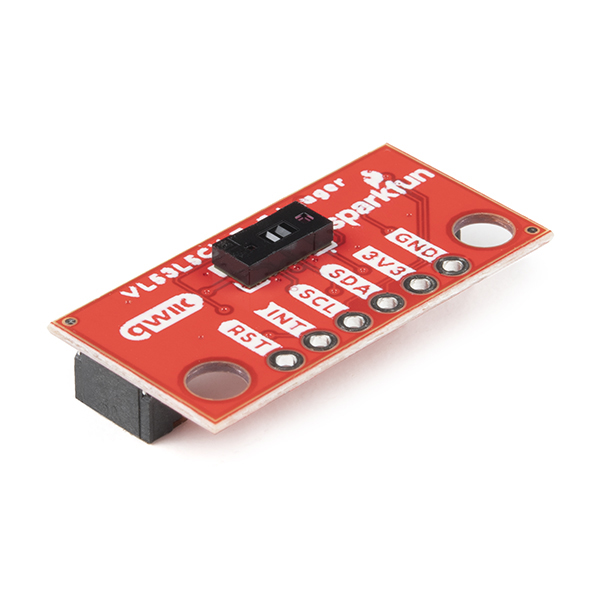SparkFun Qwiic Mini ToF Imager - VL53L5CX
The SparkFun Qwiic Mini ToF Imager is a state of the art, 64 pixel Time-of-Flight (ToF) four meter ranging sensor built around the VL53L5CX from STMicroelectronics. This Mini version has a footprint that is half the size (0.5in. x 1in.) of our standard Qwiic VL53L5CX board. Additionally, we moved the Qwiic connectors to the back of the board in a vertical orientation. These design changes favor mounting applications where the VL53L5CX sensor faces outward from an enclosure or chassis, and keeps your Qwiic cables cleanly tucked away.
The VL53L5CX chip integrates a SPAD array, physical infrared filters, and diffractive optical elements (DOE) to achieve the best ranging performance in various ambient lighting conditions with a range of cover glass materials. Utilizing our handy Qwiic system, no soldering is required to connect it to the rest of your system. However, we still have broken out some 0.1in.-spaced pins in case you prefer to use a breadboard.
Multi zone distance measurements up to 4000mm are possible across all 64 zones with a wide 63° diagonal field-of-view which can be read up to 15Hz. Thanks to ST Histogram patented algorithms, the VL53L5CX is able to detect different objects within the FoV. The Histogram also provides immunity to cover glass crosstalk beyond 60cm.
The Qwiic Mini ToF Imager is ideal for 3D room mapping, obstacle detection for robotics, gesture recognition, IoT, laser-assisted autofocus, and AR/VR enhancement; the Qwiic connector on this sensor makes integration easy.
Note: The VL53L5CX is unique in that it requires its firmware to be loaded at power-on over the I2C bus. Because this firmware is ~90k bytes, we recommend a microcontroller with enough flash to store VL53L5CX's firmware as well as your program code. Sorry, Uno's are out. But didn't you want an excuse to try out something new? We recommend choosing either an Artemis Thing Plus or an ESP32 Thing Plus board as your development board.
The SparkFun Qwiic Connect System is an ecosystem of I2C sensors, actuators, shields and cables that make prototyping faster and less prone to error. All Qwiic-enabled boards use a common 1mm pitch, 4-pin JST connector. This reduces the amount of required PCB space, and polarized connections mean you can’t hook it up wrong.
- Multizone ranging output with either 4x4 or 8x8 separate zones
- Autonomous Low-power mode with interrupt programmable threshold to wake up the host
- Up to 400cm ranging
- 60Hz frame rate capability
- Emitter: 940nm invisible light vertical cavity surface emitting laser (VCSEL) and integrated analog driver
- 63° diagonal square FoV using diffractive optical elements (DOE) on both transmitter and receiver
- Operating Voltage: 3.3V
- I2C Address: 0x52
- 2x Vertical Qwiic Connectors
- Dimensions - 0.5in. x 1in.
SparkFun Qwiic Mini ToF Imager - VL53L5CX Product Help and Resources
Qwiic ToF Imager - VL53L5CX Hookup Guide
January 27, 2022
Hookup Guide for the Qwiic ToF Imager - VL53L5CX
Core Skill: Programming
If a board needs code or communicates somehow, you're going to need to know how to program or interface with it. The programming skill is all about communication and code.
Skill Level: Rookie - You will need a better fundamental understand of what code is, and how it works. You will be using beginner-level software and development tools like Arduino. You will be dealing directly with code, but numerous examples and libraries are available. Sensors or shields will communicate with serial or TTL.
See all skill levels
Core Skill: Electrical Prototyping
If it requires power, you need to know how much, what all the pins do, and how to hook it up. You may need to reference datasheets, schematics, and know the ins and outs of electronics.
Skill Level: Rookie - You may be required to know a bit more about the component, such as orientation, or how to hook it up, in addition to power requirements. You will need to understand polarized components.
See all skill levels
Comments
Looking for answers to technical questions?
We welcome your comments and suggestions below. However, if you are looking for solutions to technical questions please see our Technical Assistance page.
Customer Reviews
4 out of 5
Based on 1 ratings:
1 of 1 found this helpful:
works as expected...
... and offers more raw data than you might want, once you know how to connect it (on a Raspberry Pico only GP4 and GP5 work by default)!







This version of the ToF sensor does not have LP broken out so it can be used in a multisensor setup. Are you planning on releasing a micro sized version with LP broken out?
The schematic of the product states that the I2C address is 0x29 while the datasheet states that it is 0x52. Is there an error on the schematic(s) or is there a different part being used?
0x29 is the correct, 7-bit unshifted address that most of the EE world uses and the address you'll need to talk to it from any library. Read more about 7-bit unshifted addresses.
If it would be mounted on the "MicroMod Qwiic Carrier Board - Single", would the Qwiic connector be easily accessible?